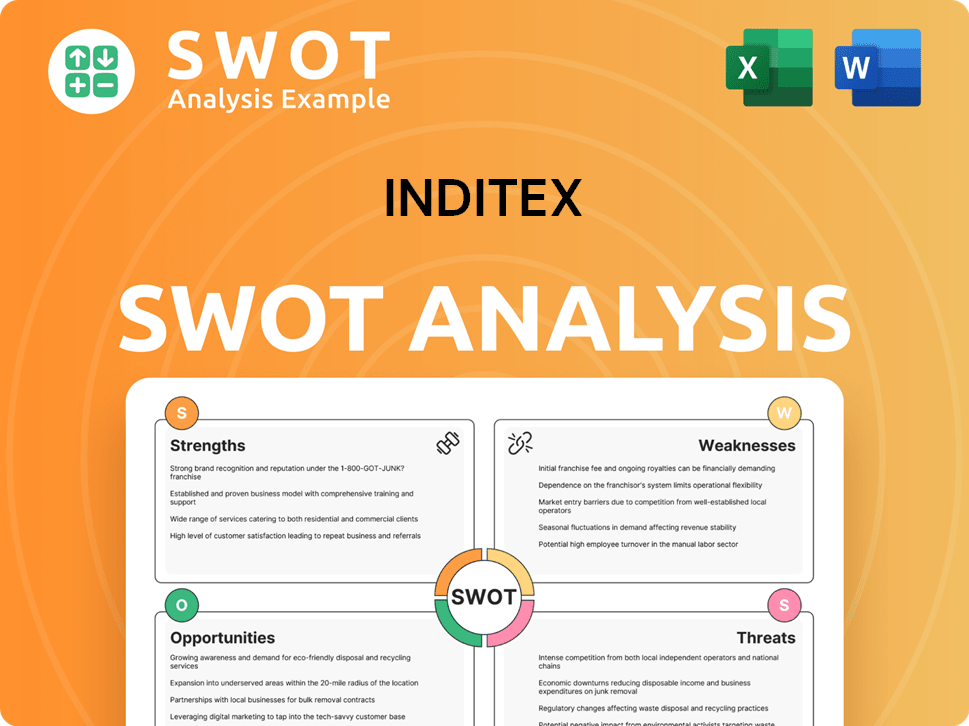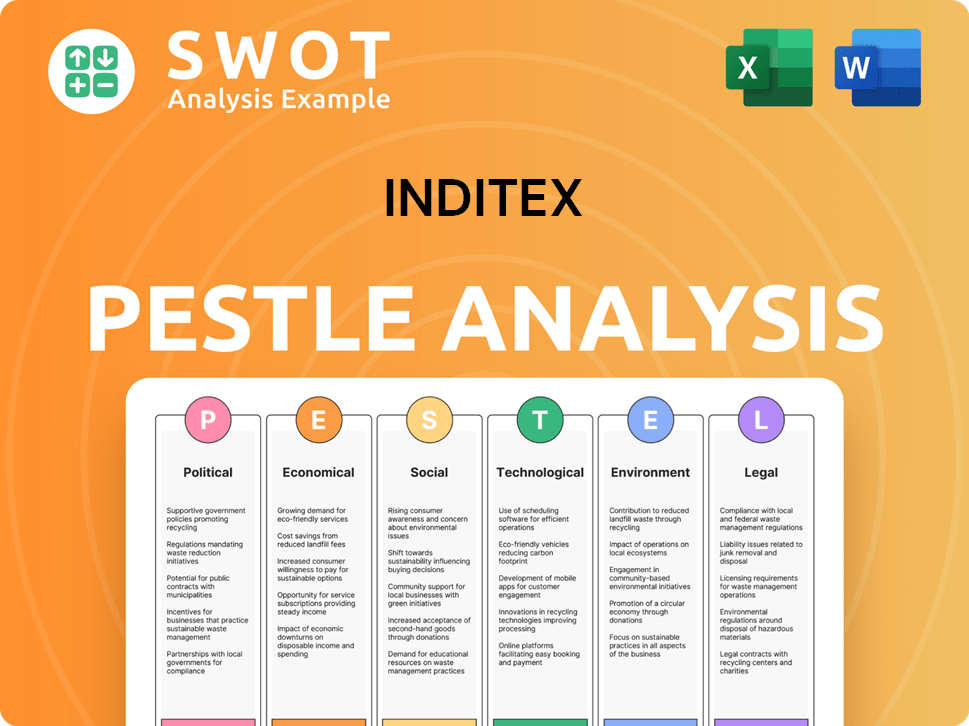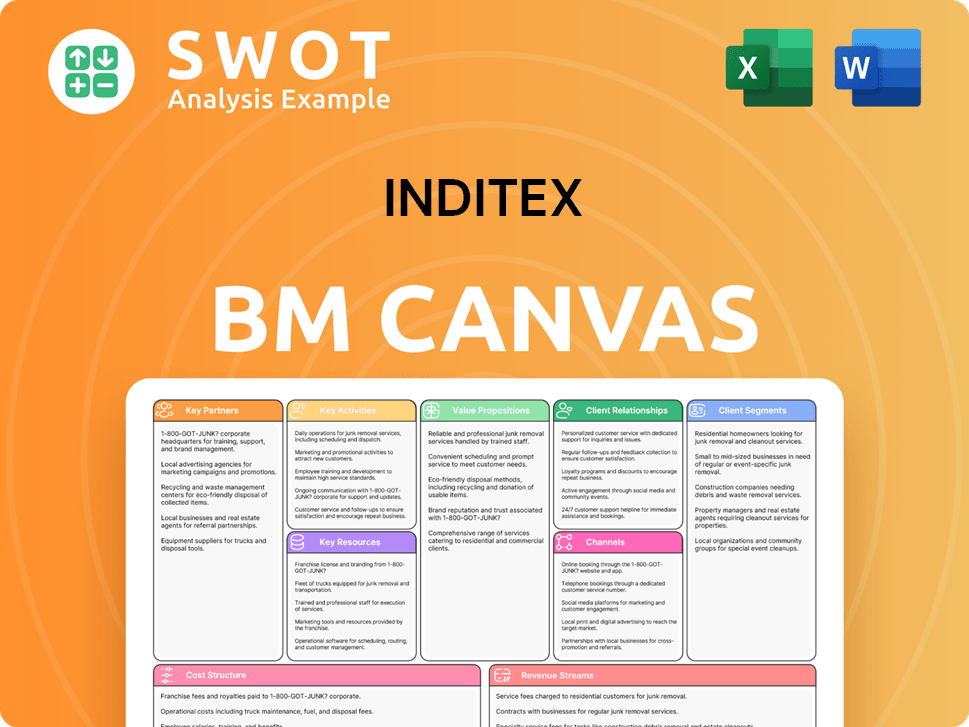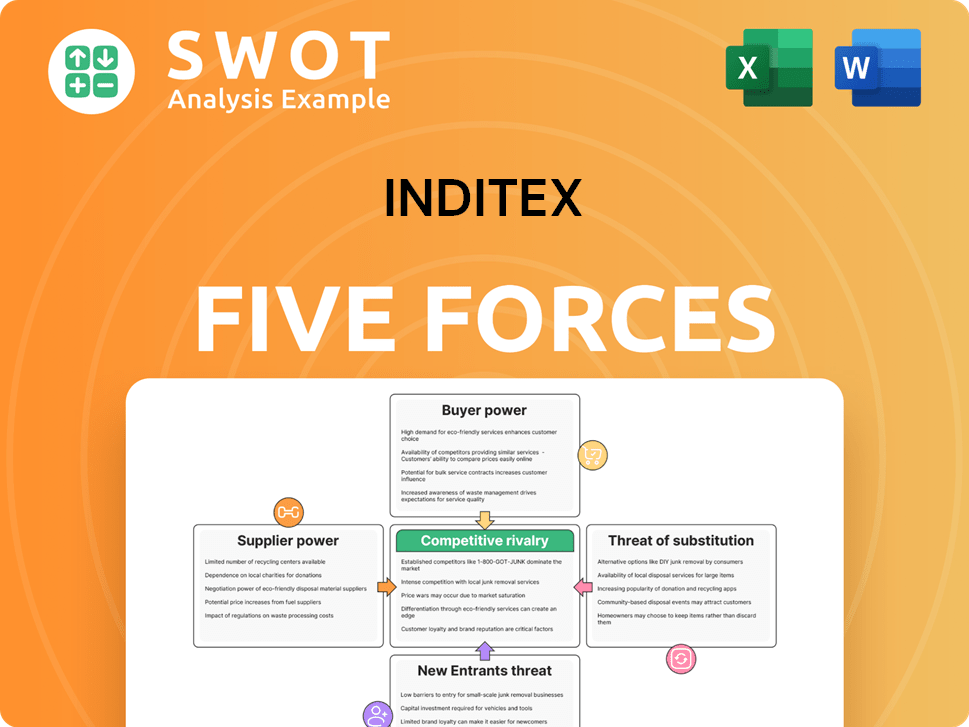Inditex Bundle
How Did Inditex Conquer the Global Fashion Stage?
Inditex, the name behind retail giants like Zara, has revolutionized the fashion world. But how did a single store in Spain transform into a global powerhouse? This Inditex SWOT Analysis delves into the fascinating

From its
What is the Inditex Founding Story?
The brief history of Inditex company began in Spain, marking a significant shift in the fashion retail landscape. The company's journey started with a single store, evolving into a global powerhouse. This initial venture laid the groundwork for a revolutionary approach to fashion.
The founding of Inditex, and specifically Zara, on May 24, 1975, by Amancio Ortega Gaona and Rosalía Mera, was a pivotal moment. Ortega's expertise in manufacturing and his understanding of fashion trends were key. This insight led to the creation of a business model that would redefine the industry.
Amancio Ortega and Rosalía Mera opened the first Zara store in A Coruña, Spain, on May 24, 1975. This marked the beginning of Inditex history and Zara history.
- Amancio Ortega, with a background in manufacturing, and Rosalía Mera, identified an opportunity to offer affordable fashion.
- The initial business model focused on vertical integration, controlling design, manufacturing, and distribution.
- The first products were affordable replicas of popular, high-fashion garments.
- The venture was largely self-funded, leveraging their textile industry knowledge.
The early years of Inditex saw a focus on rapid turnaround times for new collections, a core element of the 'fast fashion' concept. This approach allowed the company to quickly respond to consumer demand. The hands-on approach and direct control over the supply chain were crucial for early success.
Inditex SWOT Analysis
- Complete SWOT Breakdown
- Fully Customizable
- Editable in Excel & Word
- Professional Formatting
- Investor-Ready Format

What Drove the Early Growth of Inditex?
The early growth of Inditex, initially known for its Zara brand, began with a focus on expansion within Spain. The success of the first Zara store paved the way for further openings across the country during the late 1970s and early 1980s. A crucial step in the company's development was the establishment of Industria de Diseño Textil S.A. (Inditex) as a holding company in 1985, which streamlined operations and set the stage for international growth. This period highlights the Zara history and the foundation of the Inditex company background.
Following the success of the first Zara store, the company expanded its presence throughout Spain. This initial growth phase was crucial for establishing the brand and refining its business model. The late 1970s and early 1980s saw a steady increase in the number of Zara stores across Spain, laying the groundwork for future international ventures. This period is key to understanding Zara's rise to success within its home market.
In 1985, Industria de Diseño Textil S.A. (Inditex) was established as a holding company. This strategic move was pivotal for consolidating operations and setting the stage for international expansion. The formation of Inditex streamlined the company's structure, allowing for more efficient management and better preparation for entering new markets. This marks a significant point in the Inditex company timeline.
The late 1980s marked Inditex's initial foray into international markets. Zara stores opened in Portugal in 1988, followed by New York and Paris in 1989 and 1990, respectively. This internationalization was driven by the company's agile supply chain, which allowed it to adapt quickly to diverse market demands. This showcases the Inditex's global expansion history.
The 1990s saw Inditex diversifying its brand portfolio through the launch and acquisition of new brands. Pull&Bear was launched in 1991, Massimo Dutti was acquired in 1995, and Bershka was introduced in 1998. This multi-brand strategy enabled Inditex to target different consumer segments and further penetrate the global retail market, showcasing the Inditex brands history.
By the end of fiscal year 2024, Inditex operated 5,563 stores worldwide, with new store openings in 47 markets during that year. The company's online sales in 2024 soared by 12% to surpass €10 billion. This demonstrates Inditex's continued growth and adaptation to the evolving fashion retail landscape.
Inditex PESTLE Analysis
- Covers All 6 PESTLE Categories
- No Research Needed – Save Hours of Work
- Built by Experts, Trusted by Consultants
- Instant Download, Ready to Use
- 100% Editable, Fully Customizable

What are the key Milestones in Inditex history?
The Inditex history, a prominent player in the fashion retail sector, is marked by significant milestones that have shaped its trajectory from its inception to its current global presence. From its origins in Spain to its worldwide expansion, Inditex has consistently demonstrated its ability to adapt and innovate within the fast-paced fashion industry.
| Year | Milestone |
|---|---|
| 1963 | Amancio Ortega, the founder, starts a small business making clothing. |
| 1975 | The first Zara store opens in A Coruña, Spain, marking the beginning of the company's retail presence. |
| 1985 | Inditex is officially founded as the holding company for Zara and other brands. |
| 2001 | Inditex goes public, expanding its reach and resources significantly. |
| 2014 | RFID technology is implemented in Zara's factories and warehouses for real-time inventory management. |
| 2024 | Inditex invests in pioneering companies like Infinited Fiber and Epoch Biodesign, demonstrating a commitment to sustainability; the company resumes operations in markets such as Venezuela and Ukraine. |
Inditex has been a pioneer in the fashion industry, particularly through its innovative approach to the supply chain. The development of its 'fast fashion' model, enabling rapid design and distribution, has been a key factor in its success.
Inditex's agile supply chain, often referred to as 'fast fashion,' allows for rapid design, production, and distribution, minimizing lead times and quickly responding to trends.
The implementation of RFID (Radio Frequency Identification) technology in Zara's factories and warehouses starting in 2014 was a crucial technological breakthrough, enabling real-time inventory management and seamless integration between physical and online sales.
Inditex is committed to sustainability, investing in circular fibers and biorecycling startups, aiming for 100% lower-impact linen and polyester by 2025, and a 25% reduction in water consumption in its supply chain by 2025.
Despite its successes, Inditex has faced challenges, particularly concerning sustainability and market dynamics. The company has been criticized for its environmental impact, prompting it to set ambitious sustainability targets.
The fashion industry's impact on the environment has led to criticism regarding its sustainability practices, particularly concerning textile waste and production volumes.
Inditex aims for 100% lower-impact linen and polyester by 2025 and a 25% reduction in water consumption in its supply chain by 2025.
The company experienced a deceleration in annual growth to 7% in 2024, influenced by a slower performance from Zara and a loss of weight in key markets like the Americas and Asia.
Inditex Business Model Canvas
- Complete 9-Block Business Model Canvas
- Effortlessly Communicate Your Business Strategy
- Investor-Ready BMC Format
- 100% Editable and Customizable
- Clear and Structured Layout

What is the Timeline of Key Events for Inditex?
The brief history of the Inditex company shows a remarkable journey from a single store to a global fashion empire. The company's evolution, driven by strategic decisions and adaptability, has cemented its position in the fashion retail industry. From its origins in Spain to its international expansion, Inditex has consistently redefined fast fashion. The company's ability to integrate technology and sustainability into its business model highlights its commitment to future growth.
| Year | Key Event |
|---|---|
| 1975 | Amancio Ortega Gaona opened the first Zara store in A Coruña, Spain, marking the beginning of the company's journey. |
| 1985 | Inditex was established as a holding company, providing a foundation for future growth and diversification. |
| 1988 | The first international Zara store opened in Porto, Portugal, signaling the start of Inditex's global expansion. |
| 1991 | Pull&Bear was launched, expanding Inditex's brand portfolio to cater to a broader customer base. |
| 1995 | The acquisition of Massimo Dutti further diversified the company's offerings in the fashion retail market. |
| 1998 | Bershka was launched, targeting a younger demographic and enhancing Inditex's market reach. |
| 2001 | Inditex went public, providing access to capital for further expansion and reinforcing its market position. |
| 2003 | Zara Home was launched, extending the brand into home goods and lifestyle products. |
| 2014 | Implementation of RFID technology in Zara stores and logistics streamlined operations and improved efficiency. |
| 2020 | All Inditex brands eliminated plastic bags, demonstrating a commitment to environmental sustainability. |
| 2023 | The company eliminated all single-use plastics for customer sales, furthering its sustainability efforts. |
| 2024 | Sales reached €38.6 billion, with net income of €5.9 billion, and operations resumed in Venezuela and Ukraine, with the first stores opening in Uzbekistan. |
| 2025 | Expected launch of the Zara II distribution center in Zaragoza and the expansion of brands like Bershka, Oysho, and Stradivarius into new markets. |
Inditex anticipates an ordinary capital expenditure of approximately €1.8 billion in 2025. This investment will focus on optimizing commercial spaces, integrating technology, and enhancing online platforms. The company's commitment to strategic investments supports its long-term growth objectives and market competitiveness.
By 2025, Inditex aims for 100% of its cotton, linen, and polyester to be organic, sustainable, or recycled. The company is also working towards having 100% of its textile products use lower-impact materials by 2030. These goals reflect Inditex's dedication to environmental responsibility.
Inditex plans to expand its global presence with new flagship locations in strategic cities such as Nanjing, Athens, Eindhoven, and Osaka. The company is also extending its pre-owned platform to the US market and launching weekly livestreaming services in the US and UK, enhancing its digital engagement.
A significant logistics expansion plan is underway for 2024 and 2025, with an annual investment of €900 million to boost logistics capacities. The Zaragoza II distribution center for Zara is expected to commence operations in summer 2025, supporting efficient operations.
Inditex Porter's Five Forces Analysis
- Covers All 5 Competitive Forces in Detail
- Structured for Consultants, Students, and Founders
- 100% Editable in Microsoft Word & Excel
- Instant Digital Download – Use Immediately
- Compatible with Mac & PC – Fully Unlocked

Related Blogs
- What is Competitive Landscape of Inditex Company?
- What is Growth Strategy and Future Prospects of Inditex Company?
- How Does Inditex Company Work?
- What is Sales and Marketing Strategy of Inditex Company?
- What is Brief History of Inditex Company?
- Who Owns Inditex Company?
- What is Customer Demographics and Target Market of Inditex Company?
Disclaimer
All information, articles, and product details provided on this website are for general informational and educational purposes only. We do not claim any ownership over, nor do we intend to infringe upon, any trademarks, copyrights, logos, brand names, or other intellectual property mentioned or depicted on this site. Such intellectual property remains the property of its respective owners, and any references here are made solely for identification or informational purposes, without implying any affiliation, endorsement, or partnership.
We make no representations or warranties, express or implied, regarding the accuracy, completeness, or suitability of any content or products presented. Nothing on this website should be construed as legal, tax, investment, financial, medical, or other professional advice. In addition, no part of this site—including articles or product references—constitutes a solicitation, recommendation, endorsement, advertisement, or offer to buy or sell any securities, franchises, or other financial instruments, particularly in jurisdictions where such activity would be unlawful.
All content is of a general nature and may not address the specific circumstances of any individual or entity. It is not a substitute for professional advice or services. Any actions you take based on the information provided here are strictly at your own risk. You accept full responsibility for any decisions or outcomes arising from your use of this website and agree to release us from any liability in connection with your use of, or reliance upon, the content or products found herein.